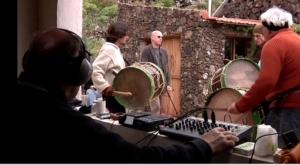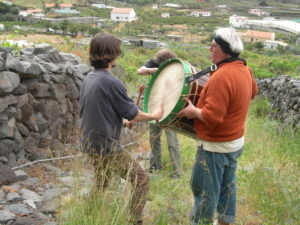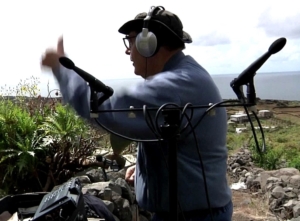El Risco
Not a documentary and not a film about nature
Tibataje (El Risco)
2015/2018 (28′22″)
Video
The “Risco de Tibataje” in the Gulf of the town of Frontera is a massif on El Hierro, the most south-westerly island of the Canary Islands. The wall is about 1,000 metres high and 8 kilometres long. The gulf is part of a crater. The other part is believed to have sunk into the sea centuries ago.
The features of the wall, there are several inlets, are peculiar and site-specific. On the one hand, the rock wall perceives any acoustic sound and reproduces it in a particular reverberation or echo. Moving sounds, such as passing cars, for example, or short signal sounds, such as the barking of a dog, the Risco picks up, modifies them and, depending on the character of the sound, releases its response. The resonance of the Risco is thus the direct form of a soundscape, as it acts as a sound box, which can be assigned certain acoustic laws of its own.
The Risco also has various shading, engravings, carvings and structures, which, depending on the light of the sun, clearly emerge from the darkness, The position of the sun also changes the colour of the sculptures from dark brown through terracotta to ochre yellow. The ever-changing clouds, which refract the sun’s light, set the static images in motion. Nature runs its own film, creating an uninterrupted “variety of shapes and colours”.
With this film, we want to creatively capture the Risco, which shows its own typical characteristics both acoustically and visually, in a sound film. It is a vision-sound- scape. Music, sound, film and individual images are balanced in relation to each other. Moreover, the respective image and sound sources are captured and abstracted.
For example, one hears the chirping of crickets directly, but also their song altered by the Risco. One perceives the slamming of a car door, the echo and then the echo itself without the sound source. The Risco itself echoes.
You see a structure static soaked in normal daylight and then again in its moving, magnificent splendour, captured by the film.
A further abstraction takes place at both sound and image level. The natural sound is electronically altered and synthesised. The natural image is translated graphically. Through this, technology-induced artificiality, nature and characteristics of the Risco are actually underlined.
It is not a documentary with music, not a nature film. It aims, through music, graphics and film, to magnify, clarify, change and rediscover the specific features of the rock face. Creative exposition with the laws of nature and their respective sensory expressions are the Leitmotif.
The Risco tells the story of a landscape. It is a visual sound impression of this environment.



